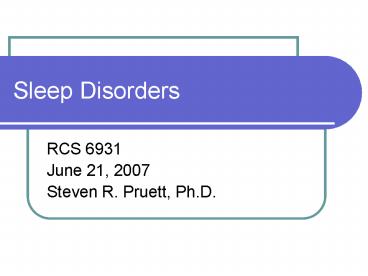Sleep Disorders - PowerPoint PPT Presentation
1 / 18
Title: Sleep Disorders
1
Sleep Disorders
- RCS 6931
- June 21, 2007
- Steven R. Pruett, Ph.D.
2
Categories of Sleep Disorders
- Dyssomnias
- Problem with quantity, quality or timing of
sleep. - Parasomnias
- Relatively normal quality, quantity and timing of
sleep, but something odd happens during sleep
itself or during the times when the patient is
falling asleep or waking up.
3
Dyssomnias
- Insomnia
- Not enough sleep is usually the presenting
complaint (for at least a month). - Usually as a result of an Axis I or II or general
medical condition (rarely shows up by itself). - MUST evaluate the cause of the Insomnia for
proper treatment decisions. - If no other Axis I, II or III disorders are made
then its Primary Insomnia 307.42 - Diagnostic Criteria
- Morrison p. 400 DSM-IV-TR p. 604
4
Dyssomnias
- Primary Hypersomnia 307.44
- Presenting complaint is that they sleep too much.
- Usually fall asleep quickly and sleep late the
next day. - Frequently complain of being chronically tired
and sleepy during the day (may take naps) - Sleep 9 hours/day
- Diagnostic Criteria
- Morrison p. 402-403 DSM-IV-TR p. 609
5
Dyssomnias
- Narcolepsy 347
- Four major symptoms (do not have to have all of
them) - Sleep attacks
- Irresistible urge to fall asleep.
- Cataplexy
- Sudden bilateral loss of muscle tone
- Hallucinations (usually visual)
- Hypnagogic or hypnopompic
- Sleep paralysis
- Sensation of being awake, but unable to move,
speak or even breathe adequately - Associated with anxiety and fear of dying (lasts
lt 10 mins)
6
Narcolepsy
- REM sleep intrusions
- Uncommon, chronic, largely hereditary disorder
that is difficult to manage requires lifelong
treatment. - No gender differences. Onset is usually in
puberty always before age 30. - Slow steady progression of symptoms
- Can lead to depression, impotence, work problems,
accidents - Not related to a general medical condition or
substances/medications - Treatment Stimulants (e.g. Ritalin)
- Diagnostic Criteria
- Morrison p. 406 DSM-IV-TR p. 615
7
Breathing-Related Sleep Disorder 780.57
- Low oxygen levels in blood
- Causes insomnia or hypersomnia
- Symptoms
- Alveolar hypoventilation syndrome
- Sleep apnea (relatively common)
- Obstructive
- Central
- Use Axis III to specify which medical condition
8
Circadian Rhythm Sleep Disorder 327.3x
- Circadian comes from about one day (circa
approximately dia day) - Presenting problem sleep-wake cycle is off
- NOTE this cycle is not constant through the
lifespan - Three major types of Circadian Rhythm Sleep
Disorder (1st two are transient
self-correcting) - Jet Lag Type 327.31
- Shift Work Type 327.35
- Delayed Sleep Phase Type 327.36
- Unspecified Type 326.30
- Diagnostic Criteria
- Morrison p. 412 DSM-IV-TR p. 629.
9
Dyssomnia NOS 307.47
- Complaints of clinically significant insomnia or
hypersomnia related to the environment (e.g.
airlines, trains, lights) - Restless legs syndrome
- Sleep deprivation sleepiness.
10
Parasomnias
- These are problems that encroach on sleep but
dont cause insomnia or hypersomnia. - Example
- Nightmares vs. Sleep apnea
- Scary vs. causing sleepiness during the next day
11
Nightmare Disorder 307.47
- Nightmares occur during REM sleep
- Those that occur during childhood have no
pathological significance. - Nightmares are very common when does it become
a disorder? - Vivid nightmares sometime precede a psychosis.
- However most Nightmares are normal a reaction to
stress - Diagnostic criteria
- Morrison p. 416 DSM-IV-TR p. 634
12
Sleep Terror Disorder 307.46
- Usually affect children (not pathological)
- Occur during non-REM sleep (most common early
during the night). - Attack lasts 5-15 minutes and ends with the
individual going back to sleep. - In adults the disorder is rare and usually
coincides with another Axis I disorder (anxiety?)
or a personality disorder. - Diagnostic Criteria
- Morrison p. 419 DSM-IV-TR 639
13
Sleepwalking Disorder 307.46
- AKA somnambuism
- Usually occurs during first third of the night
(non-REM sleep) - Some purposeful behavior is not uncommon
(dressing, eating, using bathroom) but facial
expression is blank and speech is either
non-existent or garbled. - Usually have amnesia regarding incident
- Incident can last from a few seconds to 30
minutes. - Hard to reawaken (not dangerous)
- 1-5 of children, lt1 of adults
- Diagnostic Criteria
- Morrison p. 422 DSM-IV-TR p. 644
14
Parasomnia NOS 307.47
- REM sleep behavior disorder
- Sleep paralysis
- Code these sleep issues in Axis III
- Bruxism
- Tooth grinding
- Sleep-related cluster headaches
15
Sleep disorders related to another Mental Disorder
- Insomnia related to a mental disorder 327.02
- Depression
- Anxiety disorders
- Adjustment disorders
- Somatization disorders
- Cognitive Disorders
- Manic/Hypomanic Episodes
- Schizophrenia
- OCPD
- Diagnostic Criteria
- Morrison p. 426 DSM-IV p. 650
16
Hypersomnia Related to Another Mental Disorder
327.15
- Not as common as Insomnia Related to Another
Mental Disorder - Usually due to daytime drowsiness vs. excessive
sleeping at night - Diagnostic Criteria
- Morrison p. 429 DSM-IV-TR p. 650
17
Other Sleep Disorders
- Sleep Disorder Due to a General Medical Condition
327.xx (used to be 780.xx) - Diagnostic Criteria
- Morrison p. 432 DSM-IV-TR p. 654
- Substance-Induced Sleep Disorder
- Alcohol 291.82
- Others 292.85
- Diagnostic Criteria and specifiers
- Morrison p. 435-436 DSM-IV-TR p. 660-661
18
Code Changes for Sleep Disorders
- A link to get a pdf of the corrected pages (all
49 of them) and new codes for DSM-IV-TR is
http//www.dsmivtr.org/SleepDisorderCodeChangesDSM
-IV-TR_1005.pdf































